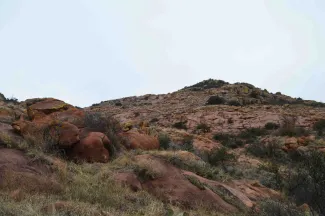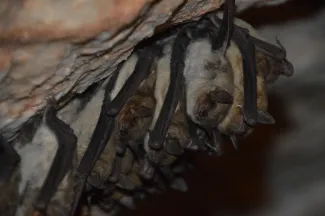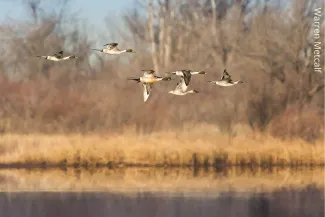Temperamental, unpredictable, and sometimes downright cold, the mere thought of Oklahoma winters can cause some wildlife enthusiasts to batten the hatches until spring green-up. Though our state does endure a few blustery, brutal, winter days there are also several mild reprieves when Oklahomans can stretch their legs and enjoy the landscape with winter hikes.
Tuck these three hiking ideas in your stocking cap while you’re waiting for winter’s next warm spell.
Trek Over Granite Boulders at Quartz Mountain Nature Park

Located north of Altus, Quartz Mountain State Park offers several granite strewn trails. Some routes, like the New Horizon Trail, provide a fun challenge and great views of Lake Altus. The lake may draw many Oklahomans during summer months, but winter hiking is a great way to enjoy the rugged park and avoid the area’s high summer temperatures.
Wildlife to Watch For: The park’s location and geography attract several species of wildlife that aren’t found in other parts of the state. Look for ladder-backed woodpeckers foraging on trees and listen from the canyon wren’s descending trill.
Go Underground at Alabaster Caverns State Park

Hiking options take a subterranean twist at Alabaster Caverns State Park near Freedom. In addition to short trails above ground, visitors can also take a ¾-mile guided tour into the largest natural gypsum cave open to the public. A cave tour is a great nature activity for cold winter days; cavern temperatures range a balmy 52-58 degrees year-round.
Wildlife to Watch For: A number of songbirds can be spotted within the park during winter hikes, but the underground tour offers a treat for wildlife enthusiasts. Small clusters of hibernating cave myotis, a small brown bat common in western Oklahoma, often form directly over the end of the cavern trail!
Wetland Walks at Salt Plains National Wildlife Refuge

Explore salt flats, ponds and wetland units at the Salt Plains National Wildlife Refuge near Jet. The Refuge’s two walking trails and auto route are bordered by water and lead visitors through small grasslands and woodlands. Observation decks along the trails are a great place to take a short break and to scan open water and mud flats for wildlife.
Wildlife to Watch For: Many of the Refuge’s waterfowl species pair up in the winter, and males are especially colorful. Look for splashes of color from northern pintails, redheads, northern shovelers and other ducks, and listen for the rattling bugle call of wintering sandhill cranes.